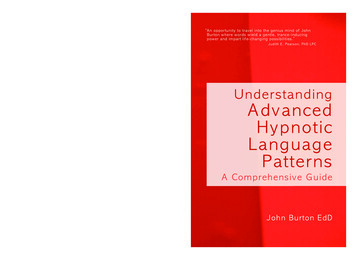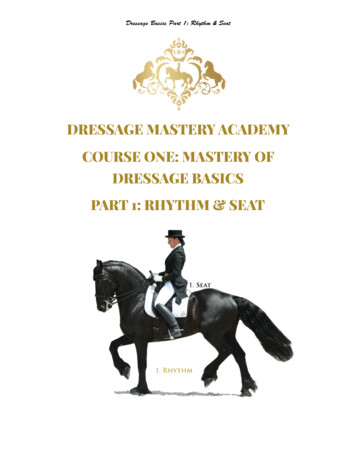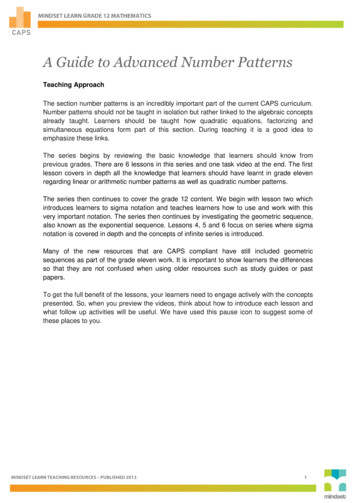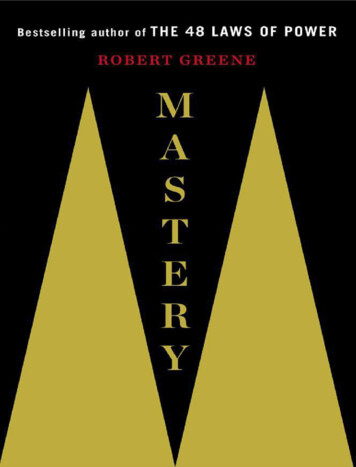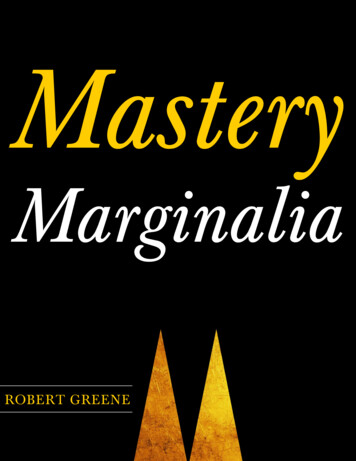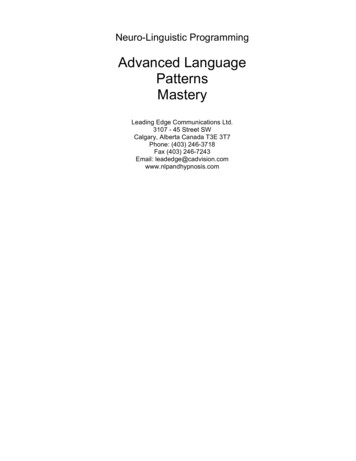
Transcription
Neuro-Linguistic ProgrammingAdvanced LanguagePatternsMasteryLeading Edge Communications Ltd.3107 - 45 Street SWCalgary, Alberta Canada T3E 3T7Phone: (403) 246-3718Fax (403) 246-7243Email: leadedge@cadvision.comwww.nlpandhypnosis.com
Business and Personal TransformationInfluence, Persuasion and CommunicationLeadership and Human InteractionDesigning In Personal, Interpersonal and Business SuccessAdvanced Language Patterns MasteryFirst Published 1992ISBN 0-9698009-0-8Larry McLauchlinLeading Edge Communications3107 - 45 Street SWCalgary, AlbertaCanadaT3E 3T7Phone (403) 246-3718Fax (403) 246-7243Email: dedge/home.htm
ACKNOWLEDGMENTSI express my admiration and thanks to Richard Bandler, John Grinder, Leslie Cameron-Bandlerand all the other members of the original research team whose thinking, wisdom, and researchlead to Neuro-Linguistic Programming.I especially thank Richard Bandler whose genius continues to develop new and effective concepts,techniques, patterns, and distinctions that have made NLP even more powerful.I also want to give credit and recognition to the many other NLP trainers and authors whose workhas influenced my life and the way that I have integrated and interpreted the material that appearsin this workshop manual. I have drawn from the work and ideas expressed by Steve and ConniraeAndreas, Robert Dilts, Tad James, Walt Woodsmall, the late Milton H. Erickson M.D., DonaldMoine, John Herd, Kenneth Lloyd and Kendrick Cleveland.I owe special appreciation to Gordon Sherley, The Sherlco Corporation, who has provided me withwhat I strongly believe to be one of the best Practitioner and Master Practitioners training availabletoday.I also want to thank the many Solution Focus and Brief Therapy authors from whom I have learneda so much. They include: Bill O'Hanlon, James Wilk, Steve de Shazer, Insoo Kim Berg, PaulWatzlawick, Steven Gilligan, John Weakland, John Walter and Jane Peller.I wish also to thank the participants of my workshops for their feedback on and refinement of thisworkshop material.Last but not least, I thank my wife, Joan, for her support and encouragement while I assembledthis workshop material and my son, Robb, for his many hours of proofreading, which greatlyimproved this manual.
Preface To the Second EditionMy purpose of putting together the material for this workshop is to provide, in one source, themajority of the hypnotic and NLP language patterns that have been codified to date. I havepresupposed that the majority of the people using this manual will have some basic training andtherefore have not attempted to duplicate what others have so ably provided already in the NLPliterature. Those who do not have this background will still find the powerful ideas and techniquesincluded here extremely useful although it will require some personal reading and self study or NLPtraining to take full advantage of it.I have not developed new patterns here, but rather I have collected together the existing patternsand provided my interpretation and examples of how these patterns can be used. I have done so ina way that will allow participants of my workshops and users of this workbook to enhance theirprofessional and communication skills.As I state in the introduction, "One of the surest and quickest ways to improve your professionaland communication skill is to increase your knowledge and skill in the use of language andlanguage patterns." It has worked for me and many others and I know it will work for you. Goodluck and enjoy your journey on the way to greater skills in the use of language.Calgary, Alberta, CanadaMay 1993
Table of ContentsIntroductionIntonation PatternsPast, Present and Future Verb TensesPresuppositionsPresuppositions (Automatically, Actuality)Presuppositions (Permanence)Presuppositions (Temporary)Presuppositions (Remembering, Forgetting)The Structure of Magic PresuppositionsSpeaking of PresuppositionsSubmodalitiesLanguage that Affects Submodalities - SpaceLanguage that Affects Submodalities - TimeLanguage that Affects Submodalities - OtherLevels of AbstractionLogical Levels of SystemsThe Milton Model and Other Hypnotic LanguageSleight of MouthReframing "Meaning and Context"Chaining Modal OperatorsCartesian LogicNegative SuggestionsInductive Language PatternsStack Representations of What is WantedElicitation of Universal ExperiencesTime Released SuggestionsSemantically Charged WordsUsing Quotes as an "Expert"StopUse Future Pacing StatementsLanguage and Creating A Desired DirectionMiscellaneous PatternsSome Powerful Suggestions for Writing and BrochuresExamples of Embedded Commands in BrochuresThe Meta ModelConcluding RemarksBibliographyAbout the AuthorWorkshop Testimonials"Advanced Language Patterns Mastery" 37475757677777879808081839597101102105106107
Advanced Language Patterns MasteryOne of the surest and quickest ways to improve your professional and communication skill is toincrease your knowledge and skill in the use of language and language patterns. Whether youwant to increase your language ability to improve your daily relationships, increase your successwith interventions, be more persuasive and influential in your occupation or just increase youreveryday effectiveness; you can and will have to do it through the use of language.It does not matter what you want to accomplish or avoid today; it is likely that you will use languagein accomplishing it. So, no matter what you want to achieve or avoid, learning and making thelanguage patterns, outlined in this workshop, available both at a conscious and an unconsciouslevel will help you immensely. In fact, you may begin to make extensive changes through the useof only language patterns.One side effect you will notice is that you will automatically begin to hear and change the languagethat has been limiting you and begin to use language to create new possibilities in all areas of yourlife.Language patterns are one of the most pervasively useful areas of communication, becauseanytime you are speaking - the words you are saying, and how you say them, makes atremendous difference. You will find that as you consciously incorporate the language patterns inthis workshop into your daily life you will be able to make changes in all areas of your life.Being in the business world, I have found language and language patterns extremely useful. Thereis one caution, I wish to address: when you use these powerful techniques, in business or otherareas, you must keep in mind that both/all parties must benefit. Being concerned only about whatyou want and not what the other person wants is a sure way to end what could be a long-termrelationship.Anytime you are talking to someone, including yourself; it is relevant what words you use. Uselanguage patterns to move yourself and others in a direction that results in a win-in situation.
Language Is Much More Than Just WordsPlease remember that language patterns are not only auditory they are also visual and kinesthetic.We really are talking about a full verbal and nonverbal experience. As we move our ownexperiences in the direction we want to move, we can notice how what we say and do matches theexperience we want to have and make whatever changes are necessary to positively affectourselves and others.Intonation PatternsLanguage patterns are made more effective through the use of total communication: both verbaland nonverbal. Studies show that communication is made up of 7% word content, 38% voiceintonation (tone, tempo, speed, and timbre) and 55% physiological gestures. Therefore, the properuse of language patterns requires not only that the word syntax be perfect but that the languagepatterns be spoken with the appropriate nonverbal gestures and analog marking (marking some ofthe words in the communication by tonal shifts, tempo shift, body shifts, small gestures, spatiallocation, etc.).The following diagram shows the intonation patterns of a question, statement, and command.Word questionWord -------- WordWord -------- WordWord statementWord -------- WordWord commandOne of the easiest ways to understand the use of intonation is through the practice and use of tagquestions. Tag questions are questions that are used to turn the uncertainty of a question into thecertainty of a statement or a command. Tag questions use word like: can you not?, isn't it?, hasn'tit?, wasn't it?, aren't you?, aren't they?, can't you?, couldn't you?, doesn't it? don't you agree?,don't we?, shouldn't it?, wouldn't it?, won't it?, hasn't it?, isn't that right?, didn't it?, can you not thinkthat? We use tag questions to invite people to share our certainty by using an intonation of acommand or a statement.
EXERCISE:Practice making each of these statements a question, a statement, and a command through theuse of intonation patterns.You have already begun to make changes, haven't you? Once you've set some goals, progress willbe much faster, won't it? You have learned a lot about yourself here, haven't you? It's worthwhatever trouble that it takes, isn't it? You all agree, don't you? Some people say this is thegreatest seminar they have taken, don't they? Language patterns are very powerful, don't youagree?
PAST, PRESENT AND FUTURE VERB TENSESTime distinctions of actions are primarily expressed in our language by verb tenses. Tense maydenote time as present, time as completed actions, time as continuous action. Just as there aredivisions of time; past, present, and future, there is verb tenses of past, present and future. Verbtenses change our subjective experience.Notice how your subjective experience changes with the following verb tense changes.1. I talked to him. (past)2. I talk to him. (present)3. I will talk to him. (future)Notice how your experience changes with the present participle "talking", in each of the three verbforms.4. I was talking to him.5. I am talking to him.6. I will be talking to him.Notice how your experience changes with the following three perfect verb forms:7. I had talked to him. (past perfect)The past perfect tense indicates action or condition as perfected or completed at some definitepast time, usually in relation to some past act. Two past acts are, therefore, indicated, one being"past past" or more past than the other.8. I have talked to him. (present perfect)The present perfect tense indicates action of condition as completed or perfected in the present orhaving started in the past and continuing only to the present.9. I will have talked to him. (future perfect)The future perfect tense indicates action or condition as perfected or completed at some specifiedfuture time or as taking place before some other future action. Two future acts are thereforeindicated, one being further into the future than the other.
USING VERB TENSES1.Verb tense can be used for putting a present problem into the past by using the past tenseand a tag question."That has been a problem, hasn't it?""That was something you did, wasn't it?"2.Verb tense can be used for putting a present problem into the completed past by starting asentence with a present tense and moving to a past tense with a tag question."That is a problem, wasn't it?""You want to solve this problem, didn't you?"3.Verb tense can be used to reorient a new behavior into the future, transform it into thepresent, and then look back on the problem behavior, or look back at yourself having madethe change."What would it be like when you have made those changes now, in the future, as you lookback and see what it was like to have had that problem. as you think about that now?" (R. Bandler)4.Use verb tenses to put problems in the past and to bring forward resources from the past,present or future."So, up until now, you have lost your temper and now you know that you can control it andwill do just that, if some little thing bothers you in the future, isn't that right."Notes:
Past, Present and FutureThe person talking is in the present.1. I talked to Richard2. I talk to Richard3. I will talk to RichardPresent Participle4. I was talking to Richard5. I am talking to Richard6. I will be talking to RichardPast Perfect7. I had talked to Richard before I made the decision.Event 7 was completed before event A.Present Perfect8. I have talked to Richard.Event 8 may or may not continue into the present.Grammar books say it must continue forward to touch the present.
Future Perfect9.I will have talked to Richard before I actually practice this technique.Event 9 will have happened before event B.Other10.Having talked to Richard, I did what I needed to do.Event 10 was complete before event C.11.Using had as an auxiliary to had.You had had a problem, hadn't you?You had had trouble speaking in public, hadn't you?12.Using present tense with past tense tag question.That is a terrible problem, wasn't it?You want to improve that, haven't you?Exercises:1. In groups of 3 experiment with using verb tenses to shift limitations into the past. A states a limitation of self or other."My friend is getting on my nerves." B and C each "reflect back" the limitation in a way that states it as being in thepast."Your friend has been getting on your nerves, lately."
2.Write out statements which presuppose that a common limitation you hear often is now in thepast.3.In groups of 3 experiment with how verb tense forms affect experience, and notice theexternal nonverbal shifts that indicate a change has taken place in the person's experience. A states a limitation and a resource or a desired resource.(B and C may quickly gather information to specify the limitation and the desiredoutcome.)"I have trouble getting things done, I need time management skills."B and C experiment with different verb shifts, and watch for nonverbal shifts in A. A givesfeedback of their experience, particularly those which move them towards their outcome."So, it has been your experience that you have had trouble doing things in the time frameyou would like, is that right?""Most people have found that they have had the skills necessary to manage their time inthe future and just need to apply them on a more conscious level now."A, B and C switch positions.Group reports back what worked well and what did not.
94.In groups of 3 experiment with putting the limitation in the past and resources in the presentand/or future. A states a limitation."I procrastinate when I'm at work." B "reflects back" the limitation putting it into the past,"So, you have been procrastinating at work." B asks for an outcome."How do you want to respond at work?" A responds"I would like to feel energetic." B places the outcome into the present or future."So, you will be feeling energetic at work when you have what you want now" C acts as a meta-person (observer) and helps A and B carry out their roles.(Note: Check ecology before leaving the outcome in the future)In groups of 3: A states a limitation and a resource.Loosing temper, want to be more in control B chooses from the matrix below where the limitation and where the resource arelocated (past, present or future) and when the resource will be used (present or future).For example: Using the limitations in the past, the resource in the present, andapplying the resource into the future; as show above.PASTLimitationResourceResource Used PRESENTFUTUREXXXXXXXXXXXXXXXXC makes the appropriate response using the required verb tenses."So, up until now (limitation in the past), you have lost your temper and now you knowthat you can control it (resource in the present) and will to do just that, if somethingbothers you in the future, isn't that right." (applying the resource in the future)
Presuppositions:'We agree (with Milton Erickson) and believe furthermore that the creative andmindful use of language is perhaps the most single influential indirect method forcreating contexts in which change is perceived to be inevitable." - William Hudson O'Hanlon& Michele Weiner Davis in "in Search of Solutions"Presuppositions are the linguistic equivalent of what most people call assumptions. They are whatmust already be assumed to be true for the statement being made to be true or make sense.Presuppositions are what must be assumed rather than what is directly stated.Whenever we are communicating we use presuppositions that assume something is already true;every sentence we speak in our everyday life has presuppositions in it. In the majority of cases wetend not to consciously recognize what we have presupposed, and concentrate on what is directlystated. Thus, the presuppositions are unconsciously accepted as being true and the listener will actas if they were true. Sometimes we presuppose what we want but a large part of the time wepresuppose what we do not want. We can greatly increase the results we get by consciouslypresupposing what we want and avoiding presupposing what we do not want.For example, we can presuppose that changes can be made quickly and automatically or thatchanges will be slow and painful. In NLP we always prefer to presuppose the former changeprocess.The following words and phrases presuppose that something happens automatically uslyeven without thinkingsecond naturesteadilyinstinctivelyalmost magicallyconstantlyinvoluntarilyunconsciouslyWe can also presuppose that something is true, actual or factual.actual, actuallyabsolutegenuineself evidentunimpeachablereal, reallytrue, trulyobviouslyfact, leverified
validclearlysure initeirrefutableIn working through this workbook it will be helpful to choose specific context orthemes to use in all the exercises.For example: Theme: Taking this seminar will make pervasive changes in your life. After taking this language patterns workshop, you may not notice, at first, how automaticallyyou begin to use these patterns.Many people who have taken this seminar believe that these proven techniques have madea pervasive change in their lives.EXERCISE:(a) Write 3 sentences that presuppose something desired as happening automatically,consistently, etc.(b) Write 3 sentences presupposing a desired fact or actuality.
Using Language Which Presupposes Permanence:lastingremainingpersistinglong standingunendingyear after yeartimelesswithout endnon-stopcontinuallyfixedgoes on and onstay with itenduringstayingpersistentlong ysindestructiblenever ceasescontinuingstablelong lastingextendedday after dayeternalnever endingceaselessin perpetuitysecurestaying powerkeeps onThe above language presupposes permanence. When talking to someone you may wish topresuppose something as being permanent.Examples of using the language of permanence:When you stop and think about the changes that you have made, you'll realize how these lastingchanges will dramatically make your life different and in many ways better than before.Now that you have realized that you have always had access to these resources, you just had notyet made the connection to how these resources could be used in many situations. You can nowbegin to discover day by day all the other resources that you already have.Exercise:Choose 5 or 6 of the above words that presuppose permanence and write out statements that youwill find useful in your area of interest.
Using Temporary Presuppositions:The following list of words are examples of words that can be used whenever you want topresuppose that a limitation will be temporary.impermanencefleetingfor a little whilefade like a shadowgo up in smokeflittingshort termsuddenly stop in a secondin a blink of an eyeimmediately changesin nothing flatat the speed of lightreplaced bychanges with the timeshere today gone tomorrowtransientbriefin an instantvanish like a dreammelt like snowfadingshort livedsuddenly gonein two shakesin an instantin short ordervanishesput in place ofchange one's mindfinalchangeableno time forfade awayburst like a bubbletemporalterminatefor a short timeabruptly gonemomentarilyin no timelike a shotevaporatesmake way forhaltstopExamples of the use of temporary presuppositions:Many people, just like you Jill, find that this condition is short lived. You may already have noticedhow the temporary belief you had in this limitation has already changed. You may already beaware how in an instant something you thought you believed with all your heart can vanish like adream and be replaced by something totally different and wonderful and lasting.Exercise:Choose 5 or 6 of the above words that presuppose something being temporary andwrite out statements that you will find useful in your area of interest.
REMEMBERING AND FORGETTINGJust as there is language that presupposes something as being permanent or temporary, there islanguage that can be used to presuppose people will remember or forget something. Using asimilar process to the one just completed on permanent and temporary presuppositions, completethe exercises on remembering and forgetting.REMEMBERbring back to memoryrefresh your memoryrecallput in one's mindprompt to rememberlasting impressionretainbearing in mindnever be forgottenindelibly impressed on your mindfixed in mindkeep in mindpersist with youFORGETdismissput out of mindthink nothing ofthink no more offorget about itlet it godon't give a second thought toturn away fromturn your attention fromput/set/lay asideforget to rememberunable to recollectunable to recalllose sight oferase from memoryslip one's minddrop from your thoughtsExercise:Choose 5 or 6 of the above words which presuppose something being remembered and write outstatements that you will find useful in your area of interest.
Exercise:Choose 5 or 6 of the above words which presuppose something being forgotten and write outstatements that you will find useful in your area of interest.
The Structure of Magic PresuppositionsIn working through the following twenty nine presuppositions from "The Structure ofMagic" (see the bibliography) it will be helpful to choose specific context or themes whichwill allow you to gain proficiency while developing useful presuppositions.The theme I will use is a) Our language creates our reality. Write your themes in b) and c)below and write your presuppositions in the space provided under each of the twenty-ninepresuppositions below.b)c)1. Some Quantifiers(ALL, EACH, EVERY, SOME, FEW, MANY, NONE) Each of us has talent that others don't haveand each of us could learn from one another, don't you agree.a)b)There are a few people who have really improved their organization once they discoveredthat they could create future possibilities through language distinctions.c)2. Generic Noun Phrases(Noun arguments standing for a whole class) I sometimes ask myself, "If great companies use thisstuff. Why don't we use it here? And I don't really know why we don't use it, do you?a)b)Sometimes I think about the great organizations that have already learned to create thedistinctions that they need to begin to invent their own reality.c)
3. Relative Clauses(Complex noun arguments, statements that have a noun followed by a phrase beginning withWHO, WHICH, or THAT) I've noticed that teams who use the meeting framework achieve morebecause they know what results they will have at the end of the meeting.a)I have noticed people and companies who consciously use language to create newdistinctions and new meanings begin to create a new future for themselves, have you noticed thatalso?b)c)4.Subordinate Clause of Time(BEFORE, AFTER, DURING, AS, SINCE, PRIOR, WHILE, YET, NOW, AGAIN) After you begin touse these skills, you will notice that you are able to develop rapport with anyone with total ease.a)After we had developed the distinction "Paradigms", we were able to begin to create newpossibilities for the company.b)c)5.Cleft Sentences(Sentences starting with IT IS or IT WAS) It is probably your intelligence that enables you to learnquickly.a)It is energizing to see how as we sit and dialogue about "Paradigms" how we actually beginto open up a whole new world of possibilities we never had before.b)c)
6. Pseudo Cleft Sentences(Identified by the form of "What [sentence) is [sentence]".) What we can learn is it is good to usepresuppositions.a)What is so important about creating a compelling future for our company is that we are ableto create new distinctions through language, and new meanings, which open up many morepossibilities for us.b)c)7. Stressed Sentences(Voice stress) I am especially interested in the OUTSTANDING results that NLP has gotten.a) It is FANTASTIC how we can use our language to create "reality".b)c)8. Complex Adjectives(NEW, OLD, FORMER, PRESENT, PREVIOUS) Are you happy with you present language patternlevel?a)Once we have created new distinctions, we can never return to the old way of thinking aboutour future.b)c)
9. Ordinal Numerals(FIRST, SECOND, THIRD, FOURTH, ANOTHER, NEXT)The tenth belief I changed was about .a)I'm not sure whether we had consciously created another distinction before "Paradigms"which also had changed our reality.b)c)10. Comparative(ER, MORE, LESS) Do you know anyone who learns even faster than you do?a)The more we use language to create new possibilities for the future, the more changes wecan make that will actually move us toward our goal.b)c)11. Comparative As(AS .AS)What else gets as many results as NLP does?a)I don't know if anything else can make as dramatic -changes as the use of language tocreate our own future.b)c)
12. Repetitive Cue Words(TOO, ALSO, EITHER, AGAIN, BACK) And you really have done well again.a)b)Again and again I have seen people and organizations create linguistic distinctions whichtotally changed their future.c)13. Repetitive Verbs and Adverbs(Verbs and adverbs beginning with "re" for example REPEATEDLY, RETURN, RESTORE,REPLACE, RENEW) If Richard Bandler returns before I leave I want to talk to him.a)b)We can repeatedly improve what we are and where we are by speaking about newpossibilities.c)14. Quantifiers(ONLY, EVEN, EXCEPT, JUST) It's not just about smoking, is it?a)It is not just about dialogue; it’s about developing common language and now languagethat opens up new possibilities.b)c)
15. Change of Time Verbs and Adverbs(BEGIN, END, STOP, START, CONTINUE, PROCEED, ALREADY, YET, STILL, ANYMORE)When you begin to use my material, you will start to get superior results.a)Once we have created a new compelling future by developing new distinctions and newopportunities, we need to continue to improve our ability to do that at even a faster rate.b)c)16. Change of State Verbs(CHANGE, TRANSFORM, TURN INTO, BECOME) It would be quite a transformation if we set upa permanent re-engineering team now, wouldn't it?a)Have you noticed how understanding the distinction "Paradigms" has already begun totransform what we do?b)c)17. Factive Verbs and Adjectives(ODD, AWARE, KNOW, REALIZE, REGRET, BELIEVE, PLEASED) Are you aware of how quicklyyou have being learning to use presuppositions?a)Are you are aware of how quickly the creation of "Paradigms" has opened up newpossibilities we didn't have with "Continuous Improvement".b)c)
18. Commentary Adjectives and Adverbs(LUCKY, FORTUNATELY, FAR OUT, OUT OF SIGHT, GROOVY, HAPPILY, NECESSARILY,REMARKABLE, INNOCENTLY) Don't you think that your language ability is remarkable?a)Some people find it surprising that language and linguistic distinctions can make such adifference to our future.b)c)19. Counterfactual Conditional Clauses(Verbs having subjective tense) If you had used language patterns well, you could have achievedeven better results.a)If we had used language to create new distinctions during our transformation we could havemade many more changes.b)c)20. Contrary to Expectation(SHOULD) If you should happen to not understand, I can explain this to you.a)If you should happen to not understand how language creates our reality, I can explain it toyou.b)c)
21. Selection RestrictionIf my professor gets pregnant, I'll be very happy. When you begin to use presuppositions, then youwill be a much better communicator.a)When people in our company begin to realize how important it is to use language to createtheir reality, then I'll be happy.b)c)22. Questions What are the stacks and stacks of results that NLP has gotten?a)How does knowing that we create our own reality through our language makeyou feel that you are more in control of your life?b)c)23. Negative QuestionsAre you not the top management consultant company in Calgary?a) Are you not creating your own possibilities through what you say and think?b)c)
24. Rhetorical QuestionsWho cares if we show up or not? What difference does it make if we solve the problem?a)Who cares what we did in the past? We can now .b)c)25. Spurious NotI wonder if you are not already more confident than most?a) I wonder if you are not already certain that the distinctions we create determine what we believe is possibleb)c)26. Proper NamesMary is coming for supper. (Mary exists)a) Jim Selman is excellent at creating clear distinctions.b)c)27. PronounsI saw her in town. (A female exists)a) It would be great if she could create rapport as well.b)c)
28. Definite DescriptionsI liked the man with the red Honda. (A man with a red Honda exists).a)b)I like the way he makes such clear distinctions between opinions, options and objectives.c)29. Change of Place Verbs(COME, GO, LEAVE, ARRIVE, DEPART, ENTER) If you arrive after I leave, go to the motel.a)When you arrive at the conclusion that we do create our future by the language we speakthen I will have done my job.b)c)Exercise:1) In groups of 3 practice the use of the 29 Structure of Magic Presuppositions. A chooses a theme that they would like to have for themselves or persuade oth
Andreas, Robert Dilts, Tad James, Walt Woodsmall, the late Milton H. Erickson M.D., Donald Moine, John Herd, Kenneth Lloyd and Kendrick Cleveland. I owe special appreciation to Gordon Sherley, The Sherlco Corporation, who has provided me with what I strongly believe to be one of the best
